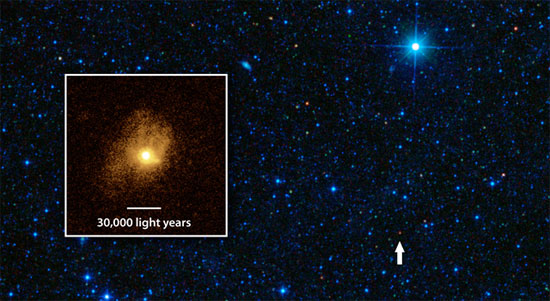Exotic galaxies turn gas into ... stars
Astronomers have found a galaxy that turns gas into stars with a success rate of approximately 100%. Its name is SDSSJ1506 + 54.
This discovery is the "victory" of the Plateau de Bure interferometer of IRAM (International Institute for Astronomical Radio waves) located at an altitude of 2,550m in the Alps, France; Infrared scanning telescope (Wide-field Infrared Survey Explorer, WISE) of NASA and Hubble Space Telescope (also by NASA).
Jim Geach of McGill University, the lead author of the new study, told Astrophysical Letters: "Galaxies burn gas like a car engine burns fuel. Most galaxies have quite impotent motives, means that they form stars at a much lower rate than the maximum theory: this galaxy is like a modified sports car, which converts gas into stars with the highest possible performance. " .
Scientists pay attention to this galaxy as they study data from WISE's infrared ray scanning. Infrared light is poured out of galaxies, equivalent to more than one trillion times the energy of our Sun.

Rare galaxies turn gas into stars. (Photo: Eurekalert)
Ned Wright of UCLA (University of California, Los Angeles, USA), the main researcher at WISE, said: "Because WISE scans the entire sky, it discovers this rare galaxy even though it stands in the extreme. difficult to observe ".
Geach said: "This galaxy is creating stars hundreds of times larger than our galaxy but Hubble's sharp image shows that most of the light of galaxies in the galaxy is emitted. from an area just a few percent of its diameter. "
The team then used IRAM's interferometer to measure the amount of gas in the galaxy. The terrestrial telescope found light from carbon monoxide, a sign of the presence of hydrogen gas, the fuel that makes stars. Combining the rate of star formation derived from WISE, and measured IRAM gas mass, scientists calculated the performance of star formation.
The results show that the star formation efficiency of the galaxy is close to the maximum theory, called the Eddington limit . In the area of galaxies, where new stars are forming, parts of the gas cloud collapse due to gravity. When gas is dense enough to squeeze atoms together and stimulate nuclear fusion, a star is born. At the same time, the wind and radiation from the newly born star can prevent the formation of new stars by putting pressure on the surrounding gas, reducing the collapse.
The Eddington limit is the point at which gravity pulls gas together in balance with external pressure from the stars. Beyond Eddington's limit, gas clouds will be blown away, blocking star formation.
Ryan Hickox, an astrophysicist at Dartmouth College, Hanover, New Hampshire, USA, a co-author of the study and said: "We see some gas coming out of this galaxy at millions of miles. one hour (1 mile = 1.61 km), and they can be blown away by the strong radiation from newly formed stars ".
Why is SDSSJ1506 54 unusual? Astronomers say they are studying the galaxy for a brief period of evolution, possibly as a result of combining the two galaxies into one. Star formation is so intense that for several tens of millions of years, the blink of an eye in a galaxy's life, gas will be consumed and galaxies will transform into a giant elliptical galaxy.
Scientists also used data from the APO Sloan Digital Sky Observatory (Apache Point Observatory) located at Mount Sacramento, New Mexico, the WMKeck observatory at Mauna Kea, Hawaii and the Observatory. Visit MMT on Mount Hopkins, Arizona. All in America.
- Detecting exotic galaxies, about 359 million light-years from Earth
- Detects 5 oversized stars on galaxies
- Stars don't form when big galaxies collide
- Explain the mystery of missing stars in the universe
- The halo in the galaxy is full of stars
- Find places to produce stars in the universe
- Stars form at record speeds in galaxies
- Two galaxies collide, producing a series of strange stars
- Dwarf galaxies contain all of gold, silver and platinum
- Journey to search for 'invisible' galaxies in the universe
- Huge heat destroys the process of forming galaxies in the universe
- Why about summer there are more stars than winter
 Van Allen's belt and evidence that the Apollo 11 mission to the Moon was myth
Van Allen's belt and evidence that the Apollo 11 mission to the Moon was myth The levels of civilization in the universe (Kardashev scale)
The levels of civilization in the universe (Kardashev scale) Today Mars, the sun and the Earth are aligned
Today Mars, the sun and the Earth are aligned The Amazon owner announced a secret plan to build a space base for thousands of people
The Amazon owner announced a secret plan to build a space base for thousands of people